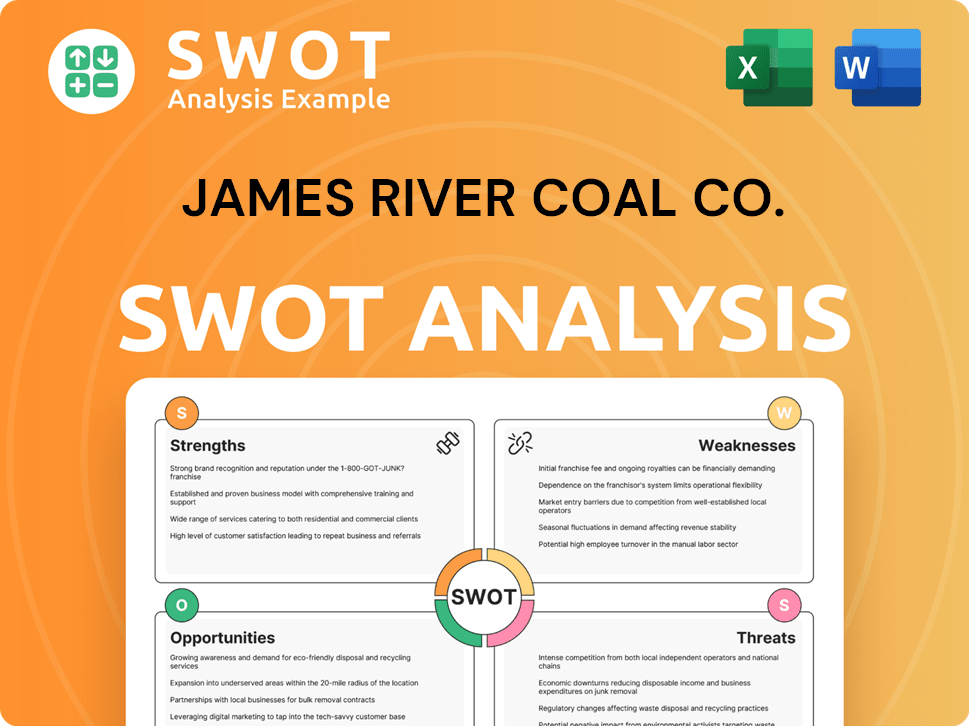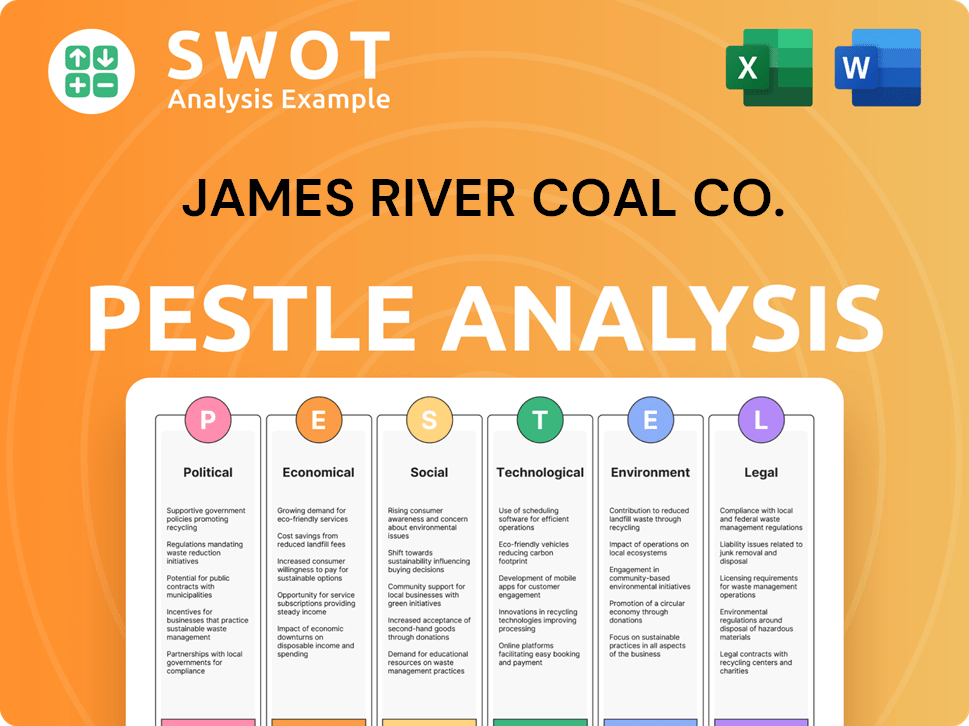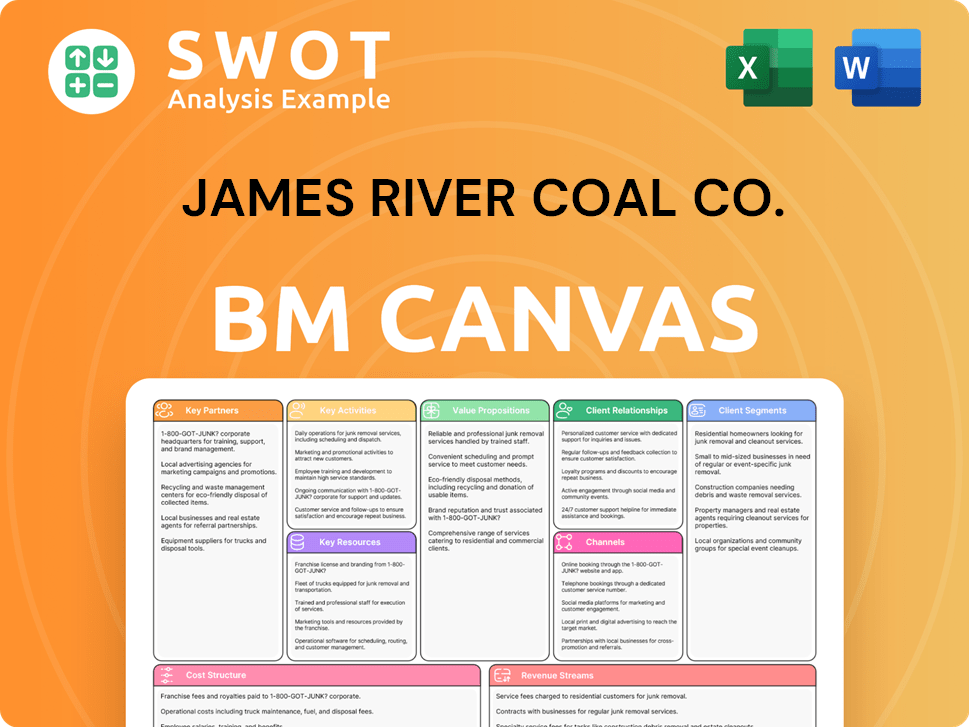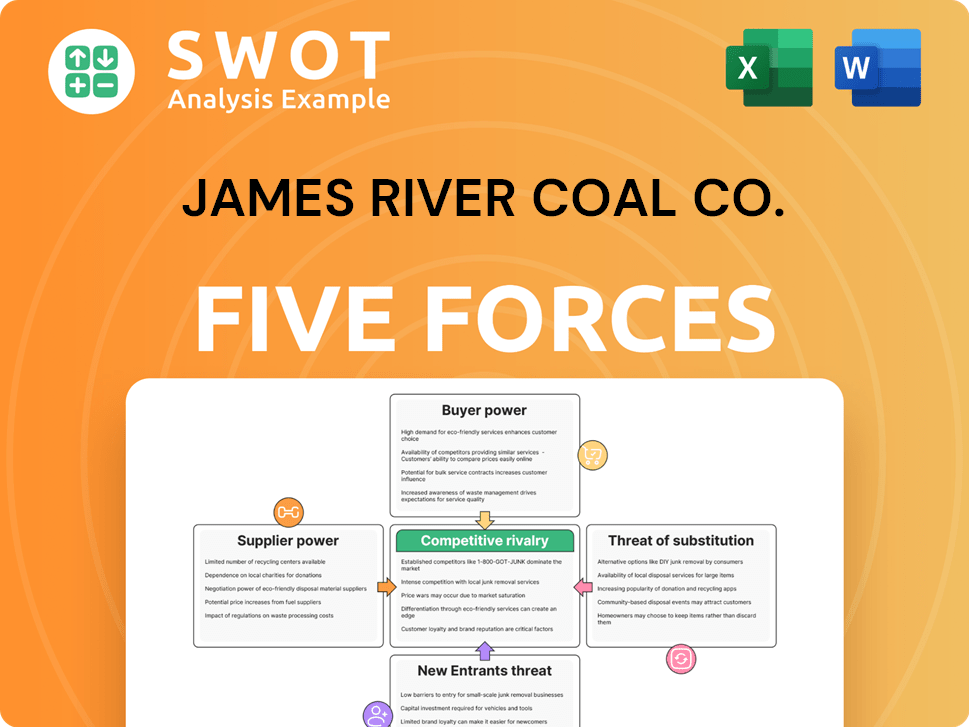James River Coal Co. Bundle
How Did James River Coal Company Navigate the Changing Coal Market?
Delve into the dramatic rise and fall of James River Coal Company, a prominent player in the American coal industry. From its strategic acquisitions in the late 1980s to its eventual bankruptcy, the company's journey offers a fascinating case study in adapting to evolving market dynamics. Discover how this James River Coal Co. SWOT Analysis can shed light on its strategic decisions.

This analysis examines James River Coal Company's sales strategy and marketing strategy within the volatile coal industry. We'll explore the company's traditional sales channels, marketing tactics, and brand positioning, providing insights into its challenges and opportunities. Understanding the factors that influenced James River Coal Company's performance offers valuable lessons for business strategists and investors alike, particularly in the context of today's evolving energy landscape and the need for robust business strategy.
How Does James River Coal Co. Reach Its Customers?
The James River Coal Company employed a sales strategy heavily reliant on direct sales. Their primary customers were electric utility companies and steel mills. This business-to-business (B2B) approach was crucial in the coal industry, where long-term contracts provided stability.
Historically, nearly 90% of James River Coal's revenue came from selling steam coal to electric utilities, particularly in the southeastern United States. The remaining revenue was generated from industrial coal sales and fees from handling synfuel products. This sales model focused on building strong relationships with key clients.
Approximately 70% of the company's sales were often secured through long-term agreements. These contracts were vital for mitigating price volatility in the coal market and ensuring a consistent revenue stream for the mining company.
James River Coal's marketing strategy focused on direct sales to electric utilities and steel mills. This approach allowed for strong B2B relationships, which were critical in the coal industry. The company's sales team likely focused on building and maintaining these key customer relationships.
A significant portion of James River Coal's sales was secured through long-term contracts. These agreements provided a stable revenue stream, which was essential for navigating the volatile coal market. Long-term contracts also helped in forecasting and managing supply.
The company's acquisitions played a crucial role in expanding its sales reach. The acquisition of IRP and L&K broadened its offerings. This strategic move allowed James River Coal to enter the global seaborne coal markets.
James River Coal's operations in key coal-producing regions provided strategic geographical proximity to high-demand markets. This proximity enabled efficient supply chain management. The company's location in areas like eastern Kentucky and southern West Virginia was advantageous.
James River Coal's sales strategy centered on direct sales to major customers and long-term contracts. The acquisition of IRP and L&K expanded its market reach. The company's focus was on both domestic and international markets.
- Direct Sales: Primarily to electric utilities and steel mills.
- Long-Term Contracts: Approximately 70% of sales secured through long-term agreements.
- Acquisition Strategy: Expansion through acquisitions like IRP.
- Geographical Advantage: Operations in key coal-producing regions.
James River Coal Co. SWOT Analysis
- Complete SWOT Breakdown
- Fully Customizable
- Editable in Excel & Word
- Professional Formatting
- Investor-Ready Format

What Marketing Tactics Does James River Coal Co. Use?
The Growth Strategy of James River Coal Co. would have heavily relied on B2B marketing tactics, given its role as a coal producer. The company's sales and marketing strategy would have prioritized direct engagement with large industrial buyers, such as electric utilities and steel mills, rather than focusing on consumer-facing campaigns. Key aspects of their approach would have included building strong relationships, ensuring supply reliability, and offering competitive pricing.
The core of the James River Coal Company 's sales strategy would have revolved around a dedicated direct sales force. This team would have been responsible for cultivating and maintaining relationships with key clients. Emphasizing the quality of their coal, particularly its low sulfur content, would have been a major selling point, especially for utilities aiming to meet environmental regulations. The company's focus on bituminous, low sulfur, steam, and industrial-grade coal would have been a significant factor in attracting customers.
Participation in industry events and conferences would have been crucial for networking and lead generation within the coal industry. These events would have offered opportunities to meet with purchasing managers, showcase the company's capabilities, and negotiate long-term supply contracts. Data-driven marketing would have played a role, involving analysis of market trends, competitor pricing, and customer-specific coal requirements.
A dedicated sales team would be the primary channel for customer interaction. This team would focus on building and maintaining relationships with key clients. They would emphasize the reliability of supply and the quality of the coal.
Attending trade shows and conferences would be essential for networking. This would allow the company to connect with potential buyers and showcase its products. These events would serve as a platform to discuss long-term supply agreements.
Analyzing market trends is crucial for informed decision-making. The company would monitor competitor pricing and understand customer-specific needs. This data would help in optimizing sales strategies.
Industry publications and trade journals would be used for advertising. This approach would target specific decision-makers within the industry. The focus would be on reaching the right audience with relevant information.
Focusing on 'just in time delivery' would be a key differentiator. This strategy would highlight operational efficiency and customer service. Partnerships, such as the one with DSI Mining America, would support this goal.
Competitive pricing would be a core element of the marketing strategy. The company would aim to offer attractive prices while maintaining profitability. This approach would help in securing and retaining customers.
The marketing strategy for a mining company like James River Coal Company would have been highly targeted, focusing on building relationships and providing reliable service. Key tactics would have included a direct sales force, participation in industry events, data-driven market analysis, and targeted advertising in industry publications. Operational efficiency, such as 'just in time delivery,' would have been a key differentiator, supported by strategic partnerships. The sales strategy would have emphasized the quality of the coal, competitive pricing, and long-term supply contracts to secure and retain customers. This approach would have been crucial for success in the competitive coal industry.
- Direct Sales Force: Building and maintaining relationships with key clients through a dedicated sales team.
- Industry Events: Participating in trade shows and conferences for networking and lead generation.
- Data-Driven Marketing: Analyzing market trends, competitor pricing, and customer-specific needs.
- Targeted Advertising: Using industry publications and trade journals for advertising.
- Operational Efficiency: Focusing on 'just in time delivery' and customer service.
- Competitive Pricing: Offering attractive prices while maintaining profitability.
James River Coal Co. PESTLE Analysis
- Covers All 6 PESTLE Categories
- No Research Needed – Save Hours of Work
- Built by Experts, Trusted by Consultants
- Instant Download, Ready to Use
- 100% Editable, Fully Customizable

How Is James River Coal Co. Positioned in the Market?
The brand positioning of James River Coal Company centered on its reputation as a dependable producer of steam and metallurgical coal. Its sales strategy highlighted the consistent supply of high-quality bituminous coal, particularly low-sulfur varieties, to key industrial sectors like electric utilities and steel mills. The company's marketing strategy focused on its established presence in vital U.S. coal basins, including Central Appalachia and the Illinois Basin.
James River Coal Company differentiated itself through its geographical advantage, providing access to essential resources and proximity to its primary markets. This strategic positioning allowed the company to cater to diverse industrial demands, offering both steam and metallurgical coal. The company's focus on productivity and cost management further reinforced a value-driven brand image in a commodity market.
The company's ability to produce both types of coal offered market versatility and resilience. In 2013, steam coal accounted for approximately 60% of its sales volume, with metallurgical coal making up the remaining 40%. This balance helped manage market fluctuations and cater to different customer needs within the coal industry.
James River Coal Company aimed to be seen as a reliable supplier. This was crucial in the coal industry, where consistent supply is essential for power generation and steel production. The company's long-term contracts with major utilities demonstrate its commitment to reliability.
The company emphasized the quality of its coal, especially low-sulfur bituminous coal. This focus on quality was important for meeting environmental regulations and the specific needs of its customers. Quality was a key element in its sales strategy.
Producing both steam and metallurgical coal gave James River Coal Company market versatility. This allowed it to serve a broader customer base and adapt to changing market conditions. This flexibility was a key part of its business strategy.
The company focused on operational efficiency and cost management to maintain a competitive edge. This emphasis on efficiency helped reinforce its value-driven brand image in a price-sensitive commodity market. This was a core element of its marketing strategy.
The brand positioning of James River Coal Company was built on several key elements.
- Reliability and Consistency: Ensuring a dependable supply of coal.
- Quality of Coal: Providing high-quality, low-sulfur coal.
- Market Versatility: Serving both steam and metallurgical coal markets.
- Operational Efficiency: Maintaining cost-effectiveness and productivity.
James River Coal Co. Business Model Canvas
- Complete 9-Block Business Model Canvas
- Effortlessly Communicate Your Business Strategy
- Investor-Ready BMC Format
- 100% Editable and Customizable
- Clear and Structured Layout

What Are James River Coal Co.’s Most Notable Campaigns?
For a company like James River Coal Company, understanding its Sales strategy and Marketing strategy involves examining key business initiatives. These initiatives, or 'campaigns,' were critical for navigating the volatile coal industry and maintaining a competitive edge. Analyzing these strategies provides insights into how the mining company aimed to secure revenue and manage its operations.
One primary 'campaign' was the strategic acquisition of International Resource Partners (IRP) and Logan & Kanawha Coal Company, LLC (L&K) in 2011. This acquisition aimed to broaden the company's product offerings and market reach, specifically in the metallurgical coal sector. Another crucial aspect was the ongoing effort to secure and maintain long-term contracts, which constituted a significant portion of its sales. These contracts were essential for mitigating price fluctuations and ensuring a steady revenue stream.
The company's eventual bankruptcy and asset sale in 2014, as discussed in the Competitors Landscape of James River Coal Co., highlight the impact of external market forces. While internal strategies were in place, external factors like environmental regulations and competition from natural gas ultimately influenced the company's performance.
The acquisition of IRP and L&K was a key initiative to increase metallurgical coal offerings. This move aimed to access international markets and expand revenue streams. The goal was to diversify the product portfolio and enhance market reach within the coal industry.
Securing long-term contracts with utilities was a continuous effort to stabilize revenue. These contracts, which often represented around 70% of sales, mitigated price volatility. Dedicated direct sales teams were involved in maintaining strong relationships with major utility companies.
Internal 'campaigns' focused on productivity and cost control to improve profitability. This included efforts to reduce expenses and maintain competitive pricing. In 2013, the reported cost was $38.16 per ton of coal sold.
The Chapter 11 bankruptcy filing in April 2014 and subsequent asset sales were a critical event. This outcome underscores the impact of external market factors on the Business strategy. External factors, such as environmental regulations, competition from natural gas, and weak economic conditions, contributed to the company's challenges.
James River Coal Co. Porter's Five Forces Analysis
- Covers All 5 Competitive Forces in Detail
- Structured for Consultants, Students, and Founders
- 100% Editable in Microsoft Word & Excel
- Instant Digital Download – Use Immediately
- Compatible with Mac & PC – Fully Unlocked

Related Blogs
- What are Mission Vision & Core Values of James River Coal Co. Company?
- What is Competitive Landscape of James River Coal Co. Company?
- What is Growth Strategy and Future Prospects of James River Coal Co. Company?
- How Does James River Coal Co. Company Work?
- What is Brief History of James River Coal Co. Company?
- Who Owns James River Coal Co. Company?
- What is Customer Demographics and Target Market of James River Coal Co. Company?
Disclaimer
All information, articles, and product details provided on this website are for general informational and educational purposes only. We do not claim any ownership over, nor do we intend to infringe upon, any trademarks, copyrights, logos, brand names, or other intellectual property mentioned or depicted on this site. Such intellectual property remains the property of its respective owners, and any references here are made solely for identification or informational purposes, without implying any affiliation, endorsement, or partnership.
We make no representations or warranties, express or implied, regarding the accuracy, completeness, or suitability of any content or products presented. Nothing on this website should be construed as legal, tax, investment, financial, medical, or other professional advice. In addition, no part of this site—including articles or product references—constitutes a solicitation, recommendation, endorsement, advertisement, or offer to buy or sell any securities, franchises, or other financial instruments, particularly in jurisdictions where such activity would be unlawful.
All content is of a general nature and may not address the specific circumstances of any individual or entity. It is not a substitute for professional advice or services. Any actions you take based on the information provided here are strictly at your own risk. You accept full responsibility for any decisions or outcomes arising from your use of this website and agree to release us from any liability in connection with your use of, or reliance upon, the content or products found herein.